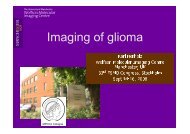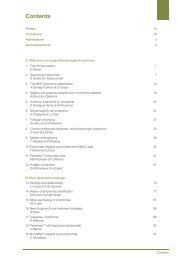Dual therapy shows potential in melanoma - European Society for ...
Dual therapy shows potential in melanoma - European Society for ...
Dual therapy shows potential in melanoma - European Society for ...
You also want an ePaper? Increase the reach of your titles
YUMPU automatically turns print PDFs into web optimized ePapers that Google loves.
First l<strong>in</strong>e oral <strong>therapy</strong> <strong>for</strong> advanced renal cell carc<strong>in</strong>oma<br />
Prescrib<strong>in</strong>g In<strong>for</strong>mation<br />
(Please refer to full SmPC be<strong>for</strong>e prescrib<strong>in</strong>g)<br />
Votrient ® (pazopanib) 200mg and 400mg film-coated tablets. Each tablet<br />
conta<strong>in</strong>s pazopanib hydrochloride, equivalent to 200mg and 400mg of<br />
pazopanib, respectively. Indication: In adults <strong>for</strong> first-l<strong>in</strong>e treatment of<br />
advanced renal cell carc<strong>in</strong>oma (RCC) and those with prior cytok<strong>in</strong>e <strong>therapy</strong>.<br />
Dosage and adm<strong>in</strong>istration: Only to be <strong>in</strong>itiated by physician experienced<br />
<strong>in</strong> use of anti-cancer agents. 800mg once daily. Take without food (≤1 hour<br />
be<strong>for</strong>e or ≥2 hours after a meal). Take tablets whole; do not break or crush.<br />
Dose modification: In 200mg steps based on <strong>in</strong>dividual tolerability to manage<br />
ADRs. Not to exceed 800mg. Renal impairment: No dose adjustment required<br />
<strong>in</strong> patients with CrCl >30ml/m<strong>in</strong>. Caution advised <strong>in</strong> patients with CrCl 3xULN occur follow<strong>in</strong>g re-<strong>in</strong>troduction,<br />
discont<strong>in</strong>ue pazopanib. If transam<strong>in</strong>ases >3xULN occur concurrently with<br />
bilirub<strong>in</strong> >2xULN, per<strong>for</strong>m bilirub<strong>in</strong> fractionation. If direct (conjugated) bilirub<strong>in</strong><br />
is >35% of total, discont<strong>in</strong>ue pazopanib. Concomitant use of pazopanib and<br />
simvastat<strong>in</strong> <strong>in</strong>creases risk of ALT elevations: Undertake with caution and close<br />
monitor<strong>in</strong>g. Hypertension: Events of hypertension, <strong>in</strong>clud<strong>in</strong>g hypertensive<br />
crisis, have occurred <strong>in</strong> pazopanib studies. Control BP prior to <strong>in</strong>itiat<strong>in</strong>g<br />
pazopanib. Monitor <strong>for</strong> hypertension early (≤1 week after start<strong>in</strong>g treatment)<br />
and frequently thereafter. Manage elevated BP with anti-hypertensive<br />
<strong>therapy</strong> and pazopanib dose modification. Discont<strong>in</strong>ue pazopanib if BP<br />
is persistently elevated (140/90 mmHg) or if arterial hypertension is severe<br />
and persists despite anti-hypertensive <strong>therapy</strong> and dose reduction. Cardiac<br />
Reference: 1. Sternberg CN, et al. Pazopanib <strong>in</strong> locally advanced and/or metastatic renal cell carc<strong>in</strong>oma:<br />
results of a randomized Phase III trial. J Cl<strong>in</strong> Oncol 2010; 28: 1061–1068.<br />
Code: ONCE/PAZ/0079c/12. Date of preparation: July 2012.<br />
VOTRIENT ® : Effectively slows down<br />
the progression of advanced<br />
renal cell cancer<br />
Offers a significant improvement <strong>in</strong> progression-free survival versus placebo <strong>in</strong>:<br />
• Treatment-naïve patients: 11.1 months vs. 2.8 months1 • Cytok<strong>in</strong>e-pretreated patients: 7.4 months vs. 4.2 months1 • Comb<strong>in</strong>ed population: 9.2 months vs. 4.2 months1 Has a low <strong>in</strong>cidence of grade 3 or 4 adverse events <strong>in</strong>clud<strong>in</strong>g fatigue, hand-foot<br />
syndrome and mucositis/stomatitis 1<br />
Ma<strong>in</strong>ta<strong>in</strong>s patients’ health-related quality of life 1<br />
dysfunction/heart failure: Consider risks/benefits of pazopanib <strong>in</strong> patients with<br />
pre-exist<strong>in</strong>g cardiac dysfunction. Safety and pharmacok<strong>in</strong>etics of pazopanib<br />
not studied <strong>in</strong> patients with moderate to severe heart failure or those with<br />
below normal LVEF. Events of cardiac dysfunction (e.g. CHF and LVEF decl<strong>in</strong>e)<br />
have occurred <strong>in</strong> pazopanib trials. Monitor patients <strong>for</strong> signs and symptoms of<br />
CHF. Basel<strong>in</strong>e and periodic LVEF evaluation recommended. QT prolongation<br />
and Torsade de Po<strong>in</strong>tes: Use with caution <strong>in</strong> patients (i) with history of QT<br />
<strong>in</strong>terval prolongation, (ii) tak<strong>in</strong>g antiarrythmics or other medications that<br />
may prolong QT <strong>in</strong>terval or (iii) with relevant pre-exist<strong>in</strong>g cardiac disease.<br />
Basel<strong>in</strong>e and periodic ECGs, and ma<strong>in</strong>tenance of electrolytes with<strong>in</strong> normal<br />
range recommended. Arterial thrombotic events: Use with caution <strong>in</strong> patients<br />
at <strong>in</strong>creased risk <strong>for</strong> these events. Base treatment decision on <strong>in</strong>dividual<br />
patient’s benefit/risk assessment. Venous thromboembolic events (VTEs):<br />
VTEs <strong>in</strong>clud<strong>in</strong>g venous thrombosis and fatal PE have occurred <strong>in</strong> pazopanib<br />
trials. Haemorrhagic events: Not recommended <strong>in</strong> patients with history of<br />
haemoptysis, cerebral, or significant GI haemorrhage <strong>in</strong> past 6 months. Use<br />
with caution <strong>in</strong> patients with significant risk of haemorrhage. GI per<strong>for</strong>ations<br />
and fistula: Use with caution <strong>in</strong> patients at risk <strong>for</strong> GI per<strong>for</strong>ation or fistula.<br />
Wound heal<strong>in</strong>g: Stop treatment ≥7 days prior to surgery. Resume after surgery<br />
based on cl<strong>in</strong>ical judgement of adequate wound heal<strong>in</strong>g. Discont<strong>in</strong>ue<br />
pazopanib <strong>in</strong> patients with wound dehiscence. Hypothyroidism: Basel<strong>in</strong>e<br />
measurement of thyroid function recommended prior to start of pazopanib<br />
treatment; Monitor periodically dur<strong>in</strong>g treatment. Monitor patients <strong>for</strong> signs<br />
and symptoms of thyroid dysfunction and manage as per standard medical<br />
practice. Prote<strong>in</strong>uria: Basel<strong>in</strong>e and periodic ur<strong>in</strong>alysis recommended.<br />
Monitor patients <strong>for</strong> worsen<strong>in</strong>g prote<strong>in</strong>uria. Discont<strong>in</strong>ue pazopanib if Grade<br />
4 prote<strong>in</strong>uria develops. Pneumothorax: Observe patients closely <strong>for</strong> signs and<br />
symptoms of pneumothorax. Infections: Cases of serious <strong>in</strong>fection (with/without<br />
neutropenia) reported. Interactions: Avoid concomitant use with strong<br />
<strong>in</strong>hibitors of CYP3A4, p-glycoprote<strong>in</strong> (P-gp) or breast cancer resistance prote<strong>in</strong><br />
(BCRP) and CYP3A4 <strong>in</strong>ducers. Hyperglycaemia observed dur<strong>in</strong>g concomitant<br />
adm<strong>in</strong>istration with ketoconazole. Undertake concomitant adm<strong>in</strong>istration<br />
with urid<strong>in</strong>e diphosphate glucuronosyl transferase 1A1 (UGT1A1) substrates<br />
and simvastat<strong>in</strong> (and other stat<strong>in</strong>s) with caution. Avoid grapefruit juice dur<strong>in</strong>g<br />
pazopanib treatment. Pregnancy and lactation: No adequate data on use<br />
<strong>in</strong> pregnant women. Not to be used unless clearly necessary; Appropriate<br />
contraception advised. Not known whether pazopanib excreted <strong>in</strong> human<br />
milk; Breastfeed<strong>in</strong>g should be discont<strong>in</strong>ued. Animal studies <strong>in</strong>dicate fertility<br />
may be affected. Effects on ability to drive and use mach<strong>in</strong>es: No studies<br />
conducted. Avoid driv<strong>in</strong>g or us<strong>in</strong>g mach<strong>in</strong>es if affected. Undesirable effects:<br />
Most important serious ADRs associated with pazopanib <strong>in</strong> cl<strong>in</strong>ical studies<br />
were: TIA, ischaemic stroke, myocardial ischaemia, myocardial and cerebral<br />
<strong>in</strong>farction, cardiac dysfunction, GI per<strong>for</strong>ation and fistula, QT prolongation;<br />
Pulmonary/GI/cerebral haemorrhage. All events occurred <strong>in</strong>
















